

利用JAVA向Mysql插入一亿数量级数据—效率测评
描述
利用JAVA向Mysql插入一亿数量级数据—效率测评
这几天研究mysql优化中查询效率时,发现测试的数据太少(10万级别),利用 EXPLAIN 比较不同的 SQL 语句,不能够得到比较有效的测评数据,大多模棱两可,不敢通过这些数据下定论。
所以通过随机生成人的姓名、年龄、性别、电话、email、地址 ,向mysql数据库大量插入数据,便于用大量的数据测试 SQL 语句优化效率。、在生成过程中发现使用不同的方法,效率天差万别。
1、先上Mysql数据库,随机生成的人员数据图。分别是ID、姓名、性别、年龄、Email、电话、住址。
下图一共三千三百万数据:
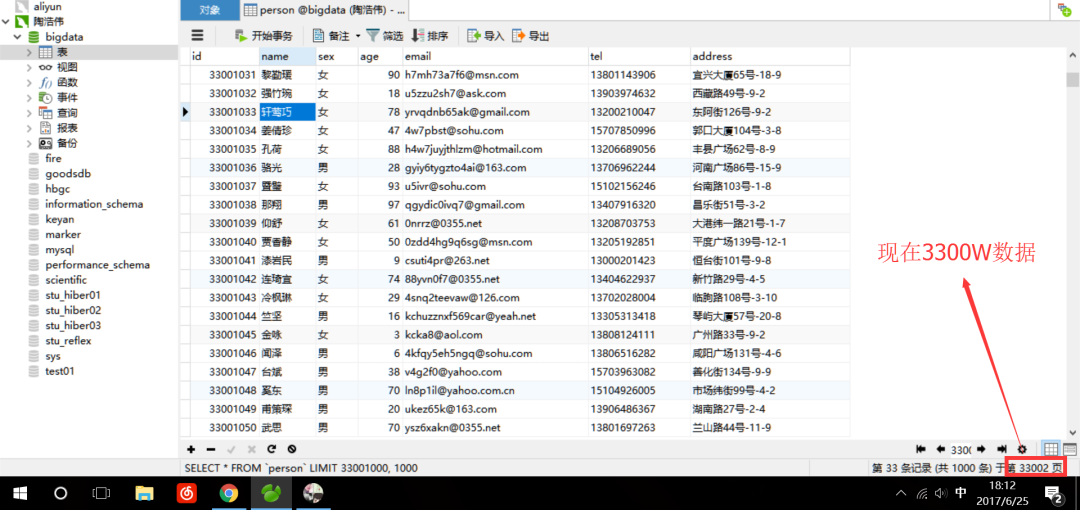
在数据量在亿级别时,别点下面按钮,会导致Navicat持续加载这亿级别的数据,导致电脑死机。~觉着自己电脑配置不错的可以去试试,可能会有惊喜
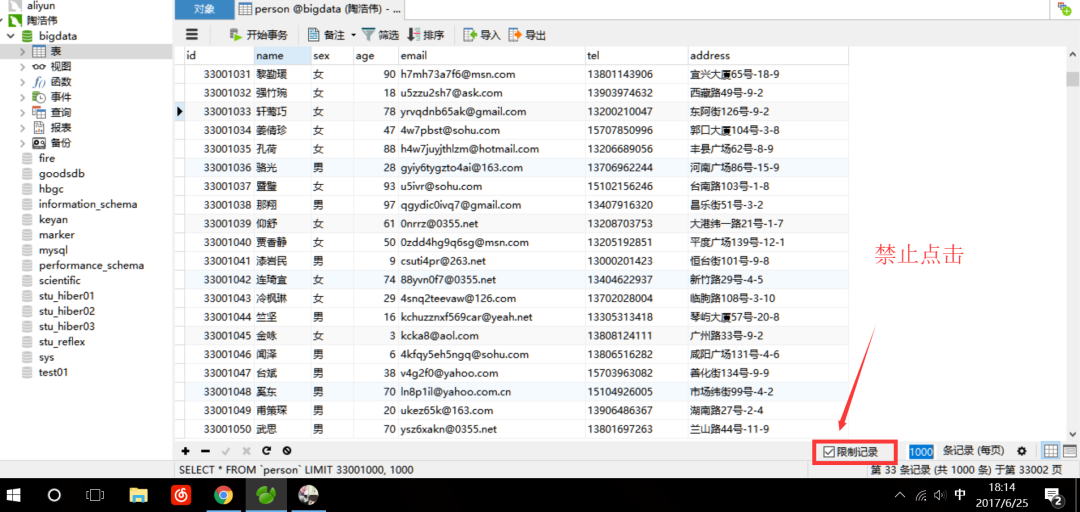
2、本次测评一共通过三种策略,五种情况,进行大批量数据插入测试
策略分别是:
- Mybatis 轻量级框架插入(无事务)
- 采用JDBC直接处理(开启事务、无事务)
- 采用JDBC批处理(开启事务、无事务)
测试结果:
Mybatis轻量级插入 -> JDBC直接处理 -> JDBC 批处理。
JDBC 批处理,效率最高
第一种策略测试:
2.1 Mybatis 轻量级框架插入(无事务)
Mybatis是一个轻量级框架,它比hibernate轻便、效率高。
但是处理大批量的数据插入操作时,需要过程中实现一个ORM的转换,本次测试存在实例,以及未开启事务,导致mybatis效率很一般。
这里实验内容是:
- 利用Spring框架生成mapper实例、创建人物实例对象
- 循环更改该实例对象属性、并插入。
//代码内无事务
private long begin = 33112001;//起始id
private long end = begin+100000;//每次循环插入的数据量
private String url = "jdbc//localhost:3306/bigdata?useServerPrepStmts=false&rewriteBatchedStatements=true&useUnicode=true&characterEncoding=UTF-8";
private String user = "root";
private String password = "0203";
@org.junit.Test
public void insertBigData2()
{
//加载Spring,以及得到PersonMapper实例对象。这里创建的时间并不对最后结果产生很大的影响
ApplicationContext context = new ClassPathXmlApplicationContext("applicationContext.xml");
PersonMapper pMapper = (PersonMapper) context.getBean("personMapper");
//创建一个人实例
Person person = new Person();
//计开始时间
long bTime = System.currentTimeMillis();
//开始循环,循环次数500W次。
for(int i=0;i<5000000;i++)
{
//为person赋值
person.setId(i);
person.setName(RandomValue.getChineseName());
person.setSex(RandomValue.name_sex);
person.setAge(RandomValue.getNum(1, 100));
person.setEmail(RandomValue.getEmail(4,15));
person.setTel(RandomValue.getTel());
person.setAddress(RandomValue.getRoad());
//执行插入语句
pMapper.insert(person);
begin++;
}
//计结束时间
long eTime = System.currentTimeMillis();
System.out.println("插入500W条数据耗时:"+(eTime-bTime));
}
本想测试插入五百万条数据,但是实际运行过程中太慢,中途不得不终止程序。最后得到52W数据,大约耗时两首歌的时间(7~9分钟)。随后,利用mybatis向mysql插入10000数据。
结果如下:
利用mybatis插入 一万 条数据耗时:28613,即28.6秒
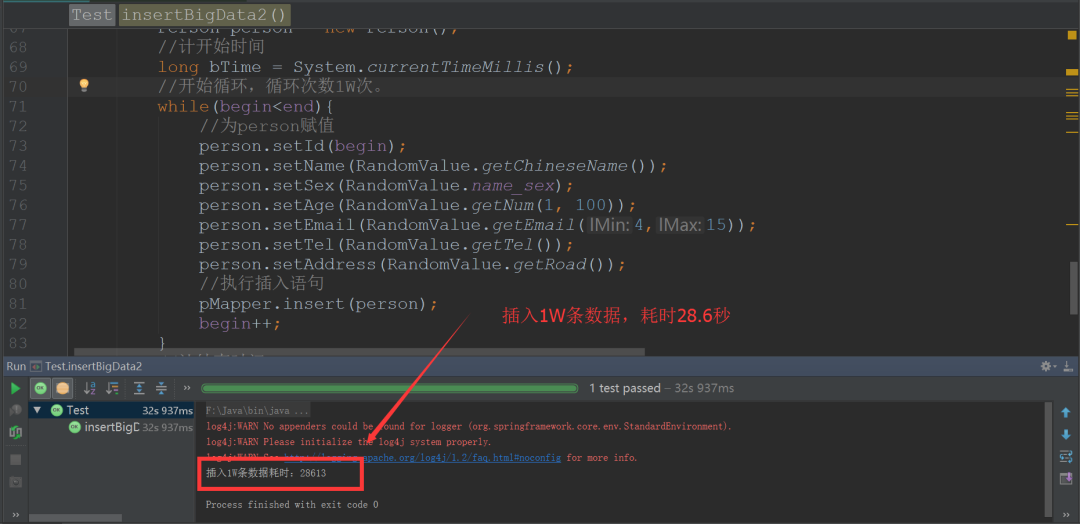
第二种策略测试:
2.2 采用JDBC直接处理(开启事务、关闭事务)
采用JDBC直接处理的策略,这里的实验内容分为开启事务、未开启事务是两种,过程均如下:
- 利用PreparedStatment预编译
- 循环,插入对应数据,并存入
事务对于插入数据有多大的影响呢? 看下面的实验结果:
//该代码为开启事务
private long begin = 33112001;//起始id
private long end = begin+100000;//每次循环插入的数据量
private String url = "jdbc//localhost:3306/bigdata?useServerPrepStmts=false&rewriteBatchedStatements=true&useUnicode=true&characterEncoding=UTF-8";
private String user = "root";
private String password = "0203";
@org.junit.Test
public void insertBigData3() {
//定义连接、statement对象
Connection conn = null;
PreparedStatement pstm = null;
try {
//加载jdbc驱动
Class.forName("com.mysql.jdbc.Driver");
//连接mysql
conn = DriverManager.getConnection(url, user, password);
//将自动提交关闭
conn.setAutoCommit(false);
//编写sql
String sql = "INSERT INTO person VALUES (?,?,?,?,?,?,?)";
//预编译sql
pstm = conn.prepareStatement(sql);
//开始总计时
long bTime1 = System.currentTimeMillis();
//循环10次,每次一万数据,一共10万
for(int i=0;i<10;i++) {
//开启分段计时,计1W数据耗时
long bTime = System.currentTimeMillis();
//开始循环
while (begin < end) {
//赋值
pstm.setLong(1, begin);
pstm.setString(2, RandomValue.getChineseName());
pstm.setString(3, RandomValue.name_sex);
pstm.setInt(4, RandomValue.getNum(1, 100));
pstm.setString(5, RandomValue.getEmail(4, 15));
pstm.setString(6, RandomValue.getTel());
pstm.setString(7, RandomValue.getRoad());
//执行sql
pstm.execute();
begin++;
}
//提交事务
conn.commit();
//边界值自增10W
end += 10000;
//关闭分段计时
long eTime = System.currentTimeMillis();
//输出
System.out.println("成功插入1W条数据耗时:"+(eTime-bTime));
}
//关闭总计时
long eTime1 = System.currentTimeMillis();
//输出
System.out.println("插入10W数据共耗时:"+(eTime1-bTime1));
} catch (SQLException e) {
e.printStackTrace();
} catch (ClassNotFoundException e1) {
e1.printStackTrace();
}
}
1、我们首先利用上述代码测试无事务状态下,插入10W条数据需要耗时多少。
如图:
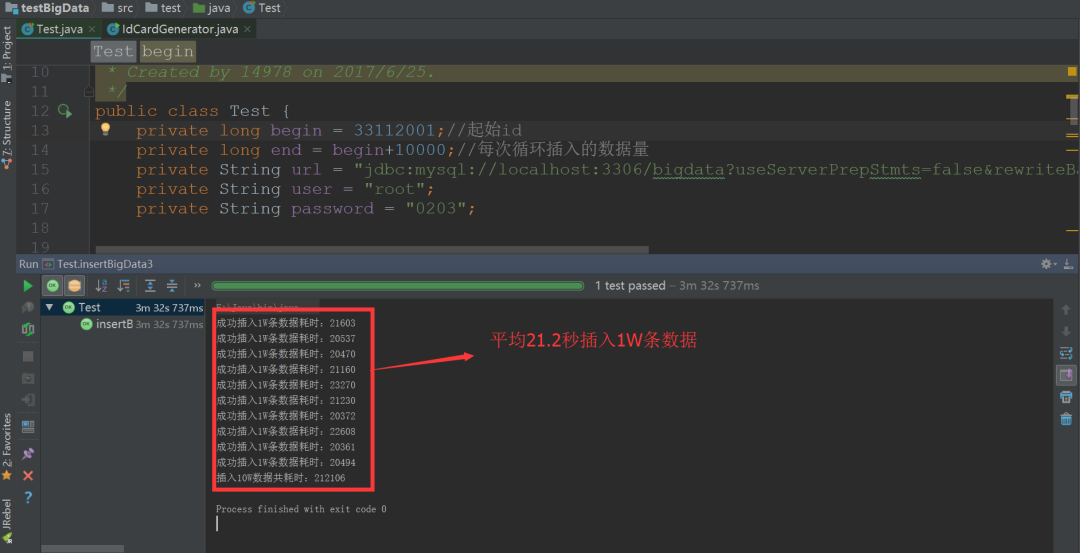
成功插入1W条数据耗时:21603
成功插入1W条数据耗时:20537
成功插入1W条数据耗时:20470
成功插入1W条数据耗时:21160
成功插入1W条数据耗时:23270
成功插入1W条数据耗时:21230
成功插入1W条数据耗时:20372
成功插入1W条数据耗时:22608
成功插入1W条数据耗时:20361
成功插入1W条数据耗时:20494
插入10W数据共耗时:212106
实验结论如下:
在未开启事务的情况下,平均每 21.2 秒插入 一万 数据。
接着我们测试开启事务后,插入十万条数据耗时,如图:
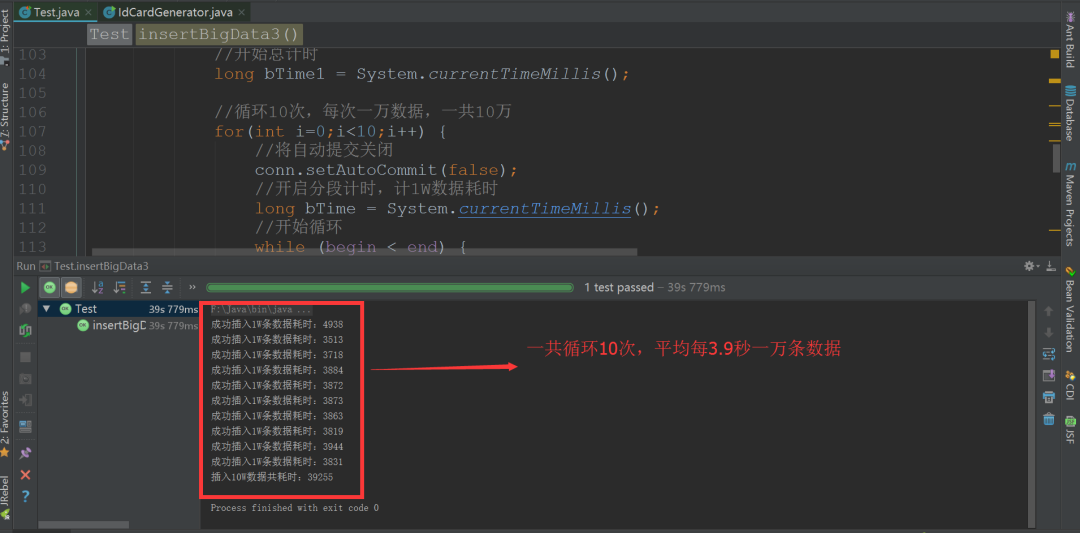
成功插入1W条数据耗时:4938
成功插入1W条数据耗时:3518
成功插入1W条数据耗时:3713
成功插入1W条数据耗时:3883
成功插入1W条数据耗时:3872
成功插入1W条数据耗时:3873
成功插入1W条数据耗时:3863
成功插入1W条数据耗时:3819
成功插入1W条数据耗时:3933
成功插入1W条数据耗时:3811
插入10W数据共耗时:39255
实验结论如下:
开启事务后,平均每 3.9 秒插入 一万 数据
第三种策略测试:
2.3 采用JDBC批处理(开启事务、无事务)
采用JDBC批处理时需要注意一下几点:
1、在URL连接时需要开启批处理、以及预编译
String url = “jdbc//localhost:3306/User?rewriteBatched
-Statements=true&useServerPrepStmts=false”;
2、PreparedStatement预处理sql语句必须放在循环体外
代码如下:
private long begin = 33112001;//起始id
private long end = begin+100000;//每次循环插入的数据量
private String url = "jdbc//localhost:3306/bigdata?useServerPrepStmts=false&rewriteBatchedStatements=true&useUnicode=true&characterEncoding=UTF-8";
private String user = "root";
private String password = "0203";
@org.junit.Test
public void insertBigData() {
//定义连接、statement对象
Connection conn = null;
PreparedStatement pstm = null;
try {
//加载jdbc驱动
Class.forName("com.mysql.jdbc.Driver");
//连接mysql
conn = DriverManager.getConnection(url, user, password);
//将自动提交关闭
// conn.setAutoCommit(false);
//编写sql
String sql = "INSERT INTO person VALUES (?,?,?,?,?,?,?)";
//预编译sql
pstm = conn.prepareStatement(sql);
//开始总计时
long bTime1 = System.currentTimeMillis();
//循环10次,每次十万数据,一共1000万
for(int i=0;i<10;i++) {
//开启分段计时,计1W数据耗时
long bTime = System.currentTimeMillis();
//开始循环
while (begin < end) {
//赋值
pstm.setLong(1, begin);
pstm.setString(2, RandomValue.getChineseName());
pstm.setString(3, RandomValue.name_sex);
pstm.setInt(4, RandomValue.getNum(1, 100));
pstm.setString(5, RandomValue.getEmail(4, 15));
pstm.setString(6, RandomValue.getTel());
pstm.setString(7, RandomValue.getRoad());
//添加到同一个批处理中
pstm.addBatch();
begin++;
}
//执行批处理
pstm.executeBatch();
//提交事务
// conn.commit();
//边界值自增10W
end += 100000;
//关闭分段计时
long eTime = System.currentTimeMillis();
//输出
System.out.println("成功插入10W条数据耗时:"+(eTime-bTime));
}
//关闭总计时
long eTime1 = System.currentTimeMillis();
//输出
System.out.println("插入100W数据共耗时:"+(eTime1-bTime1));
} catch (SQLException e) {
e.printStackTrace();
} catch (ClassNotFoundException e1) {
e1.printStackTrace();
}
}
首先开始测试
无事务,每次循环插入10W条数据,循环10次,一共100W条数据。
结果如下图:
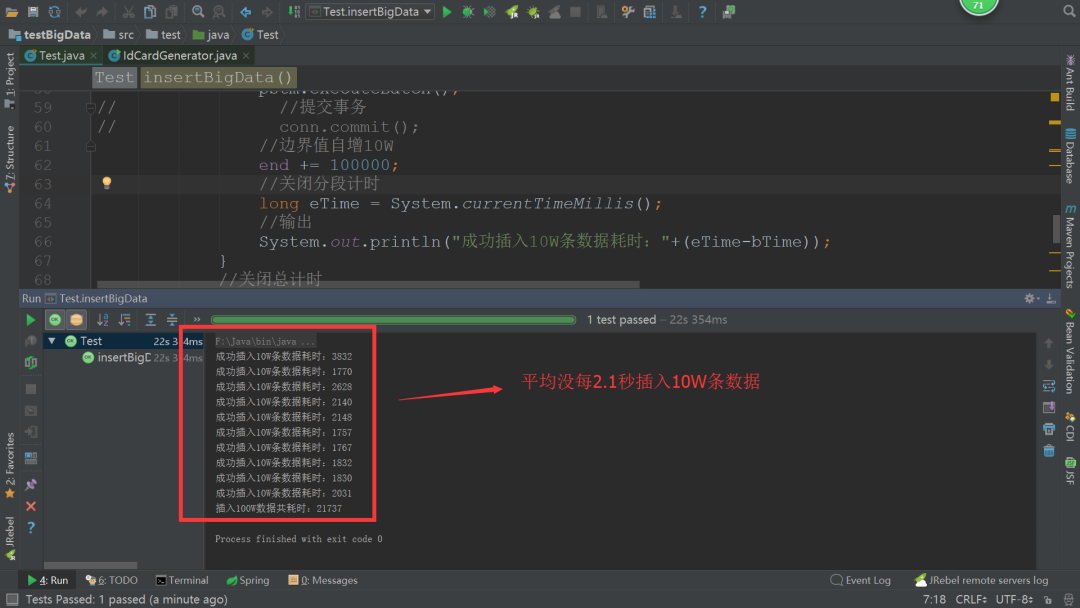
成功插入10W条数据耗时:3832
成功插入10W条数据耗时:1770
成功插入10W条数据耗时:2628
成功插入10W条数据耗时:2140
成功插入10W条数据耗时:2148
成功插入10W条数据耗时:1757
成功插入10W条数据耗时:1767
成功插入10W条数据耗时:1832
成功插入10W条数据耗时:1830
成功插入10W条数据耗时:2031
插入100W数据共耗时:21737
实验结果:
使用JDBC批处理,未开启事务下,平均每 2.1 秒插入 十万 条数据
接着测试
开启事务,每次循环插入10W条数据,循环10次,一共100W条数据。
结果如下图:
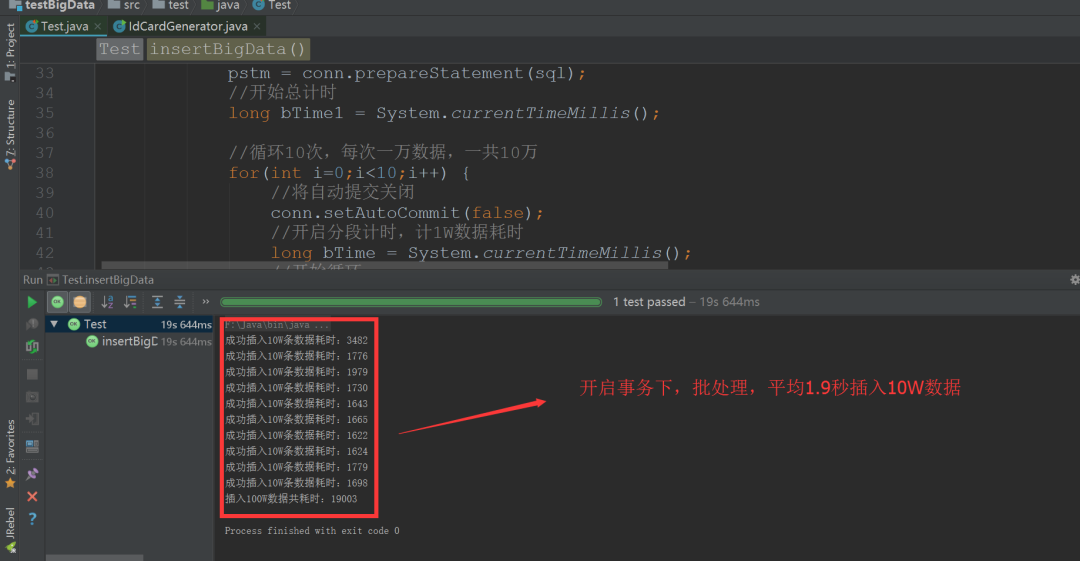
成功插入10W条数据耗时:3482
成功插入10W条数据耗时:1776
成功插入10W条数据耗时:1979
成功插入10W条数据耗时:1730
成功插入10W条数据耗时:1643
成功插入10W条数据耗时:1665
成功插入10W条数据耗时:1622
成功插入10W条数据耗时:1624
成功插入10W条数据耗时:1779
成功插入10W条数据耗时:1698
插入100W数据共耗时:19003
实验结果:
使用JDBC批处理,开启事务,平均每 1.9 秒插入 十万 条数据
3 总结
能够看到,在开启事务下 JDBC直接处理 和 JDBC批处理 均耗时更短。
-
Mybatis 轻量级框架插入 , mybatis在我这次实验被黑的可惨了,哈哈。实际开启事务以后,差距不会这么大(差距10倍)。大家有兴趣的可以接着去测试
-
JDBC直接处理,在本次实验,开启事务和关闭事务,耗时差距5倍左右,并且这个倍数会随着数据量的增大而增大。因为在未开启事务时,更新10000条数据,就得访问数据库10000次。导致每次操作都需要操作一次数据库。
-
JDBC批处理,在本次实验,开启事务与关闭事务,耗时差距很微小(后面会增加测试,加大这个数值的差距)。但是能够看到开启事务以后,速度还是有提升。
结论:设计到大量单条数据的插入,使用JDBC批处理和事务混合速度最快
实测使用批处理+事务混合插入1亿条数据耗时:174756毫秒
4 补充
JDBC批处理事务,开启和关闭事务,测评插入20次,一次50W数据,一共一千万数据耗时:
1、开启事务(数据太长不全贴了)
插入1000W数据共耗时:197654
2、关闭事务(数据太长不全贴了)
插入1000W数据共耗时:200540
还是没很大的差距~
借用:
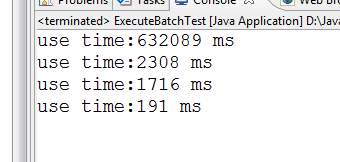
分别是:
- 不用批处理,不用事务;
- 只用批处理,不用事务;
- 只用事务,不用批处理;
- 既用事务,也用批处理;(很明显,这个最快,所以建议在处理大批量的数据时,同时使用批处理和事务)
审核编辑 :李倩
-
使用tina测量opa227的输入失调电压和失调电流,结果数量级和手册标准值差很多,为什么?2024-09-14 543
-
0基础学Mysql:mysql入门视频教程!2017-07-08 2901
-
labview的采样率上限数量级是10^6吗?2018-09-28 3149
-
使用Matlab捕获N9010A跟踪数据缩放了几个数量级2018-11-05 1969
-
请问AD9361跳频稳定时间是一个什么数量级?2019-02-15 5715
-
开关电源的NTC阻值一般是什么数量级的?2019-10-09 3836
-
labview插入数据MySQL数据库2019-12-26 5400
-
如何实现处理器的速度跟外围硬件设备的速度在一个数量级上呢2022-02-11 593
-
深度剖析OpenHarmony轻量级数据存储2022-03-31 2465
-
中国电子系统2天时间建设苏州市疫情管控平台 可同时支持10万数量级企业及1000万数量级员工的活动轨迹分析2020-03-03 4113
-
MySQL数据库:如何操作禁止重复插入数据2020-10-08 3875
-
TinyDB轻量级数据库有哪些特点呢2022-10-28 2537
-
利用JAVA向Mysql插入一亿数量级数据2023-04-03 1763
-
轻量级数据库有哪些2023-08-28 7314
-
如何在不受电线等的影响下尽可能准确地测量如mΩ数量级的电阻值呢?2023-11-17 1154
全部0条评论

快来发表一下你的评论吧 !

